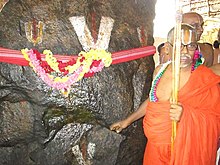Ahobila Matha

The Ahobila Matha is a Vadakalai Sri Vaishnava monastery established around 1400 CE at Ahobilam in Andhra Pradesh, India following the Vadakalai tradition of Vedanta Desika. It was founded by Sri Adivan Satakopa Swami(An acharya for both Thenkalai and Vadakalai Srivaishnava traditions, known in purvashrama as Thirunarayanapuram (Melkote) Kidambi Srinivasacharya). by the divine order of Sri Ahobila Narasimha.
Sri Adhivan Satakopa Jeeyar Swami was a Thenakalai and Vadakalai saint, who was a great grand disciple of Vedanta Desika and a sishya of Ghatikasatham Ammal (by kalakshepa), the scholarly successor of the celebrated Sri Vaishnava stalwart Nadadoor Ammal, founded and established the Matha, based on the Sri Pancharatra tradition. Ahobila Mutt was intended to be a Vadakalai sampradaya by the founder Acharya.Although he is the Acharya for both Tenkalai and Vadakali traditions
The Matha
[edit]As per legend, one of the nine Narasimhas of Ahobilam called Lord Malolan jumped into the hands of Srinivasacharya and ordered him to travel the length and breadth of the country.
Current Acharya
[edit]
The current Acharya is the 46th Jeeyar Srivan Satakopa Sri Ranganatha Yateendra Mahadesikan. He succeeded the previous pontiff 45th Jeeyar Sri Lakshmi Nrsimha Divya Paduka Sevaka Srivan Satakopa Sri Narayana Yateendra Mahadesikan who attained Acharyan Thiruvadi on 19 May 2013.
Temples under purview
[edit]Several temples such as the Nine (Nava) Narasimha temples of Ahobilam, Veeraraghava temple in Tiruvallur and Valvil Rama temple, Aandalakkum ayyan temple in the outskirts of Kumbakonam (Pullaboothankudi), Sri Vedanta Desikan Sannidhi facing Sri Ranganayaki Thayar inside the premises of Sringam Temple , Sri Dasavathara Sannidhi established by Sri Thirumangai Azhwar in Kollidaikarai, Sri Nava Narasimha Temple in Naimisharanya are administered by Ahobila Matha.
The Matha also has several branches across India.
Sri Ahobila Matha Lakshmi Narasimha Lakshmi Narayana Temple, Ahobila Matha Marg, Chembur in Mumbai. The Ahobila Matha temple in Chembur, Established in 1968, is a preeminent religious center in this northern suburb of Mumbai.
Institutions administered
[edit]
The Ahobila Matha has several religious and educational institutions in India which are:[1]
- Sri Ahobila Matha Sanskrit College (Est. 1942)
- Sri Ahobila Matha Veda Patashala (Est. 1942)
- Sri Ahobila Matha Oriental High School (Est. 1952)
- Sri Ahobila Matha Center for Human Resource Development (Est. 2002)
- Sri Malolan College of Arts and Science, Madurantakam, (Est. 2009)
See also
[edit]References
[edit]External links
[edit]- Official site of Sri Ahobila Matha
- Ahobila Matha Mysore (website)
- Ahobila Matha Chembur, Mumbai (website)
